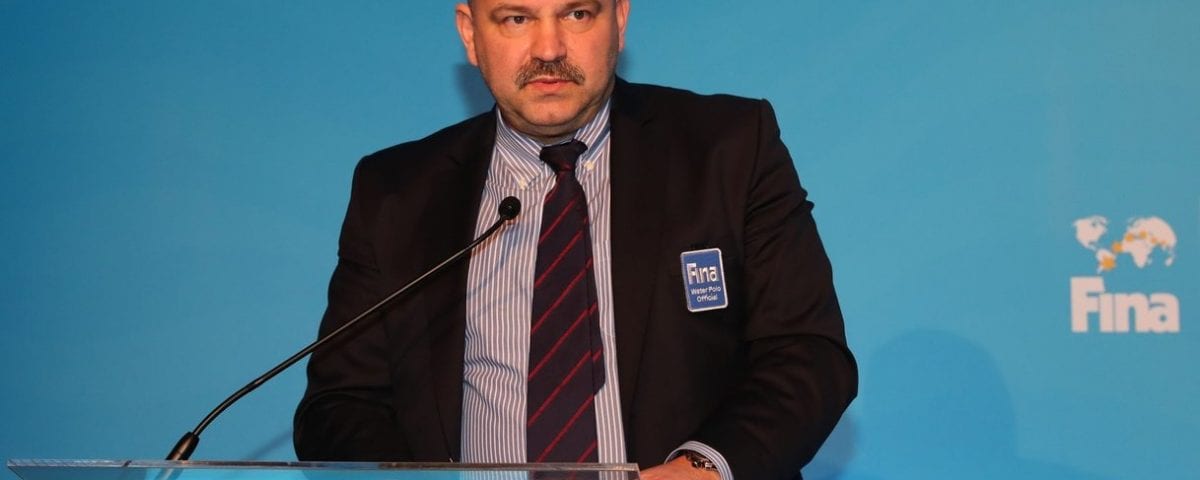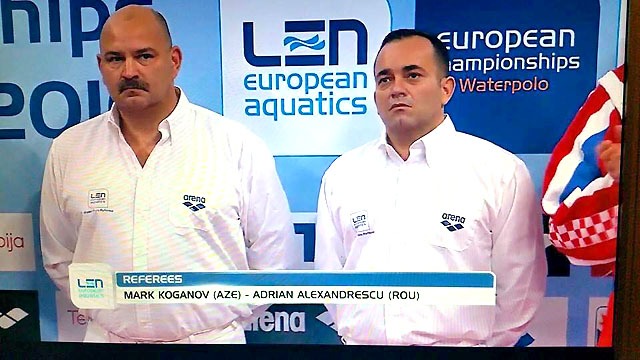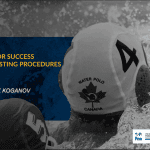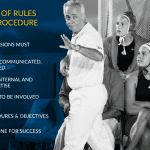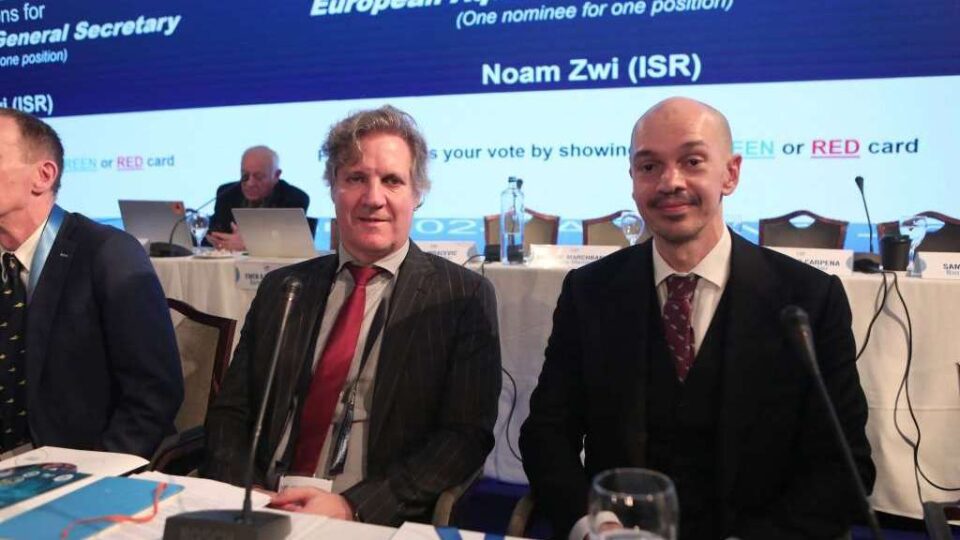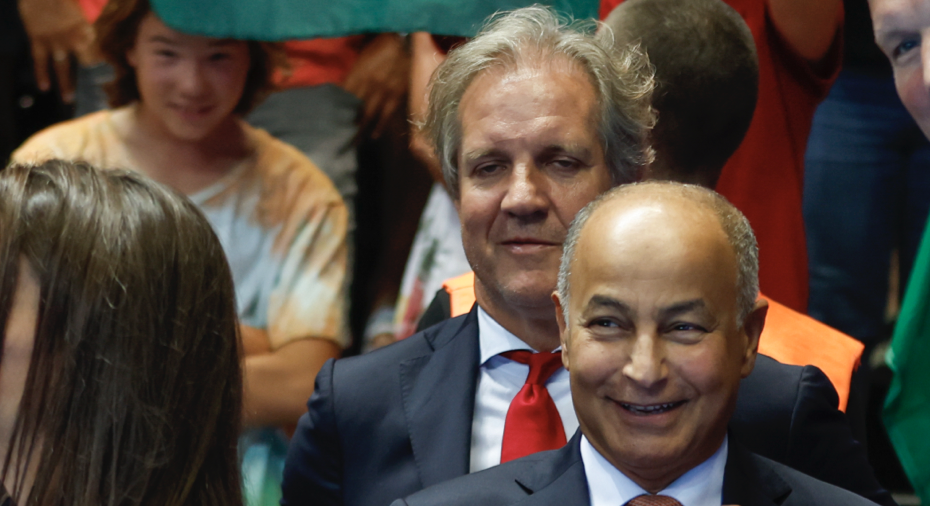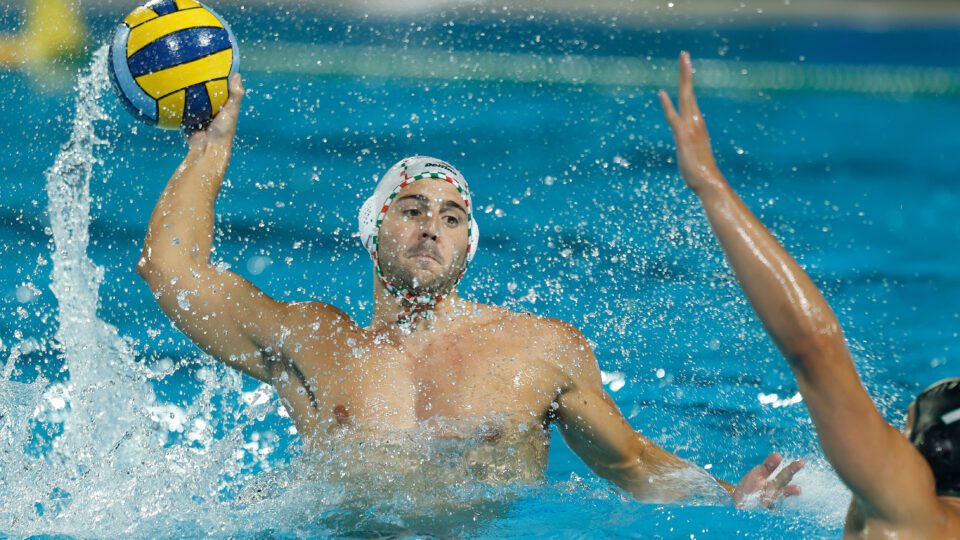After playing in the Soviet Union, then being a FINA referee, Mark Koganov is now the Vice President of the Technical Committee of FINA for Water Polo (TWPC), and a member of LEN TWPC as well. As he was building his career, he became a big name in the water polo world.
In or close to the pools since the age of seven, his growing list of accomplishments is impressive. During his referee career, he has been considered one of the best in the world. In addition to the various European and World Championships, he represented Azerbaijan as a neutral referee during the last Rio Olympics.
On top of his career, Koganov is one of the main actors in the elaboration of the new water polo rules.
As a former player and referee, could you compare water polo you played back in the day with today’s game? And what do you think of the water polo’s evolution for the last few decades?
I think that the evolution of water polo towards a more dynamic, more physically demanding, more power-oriented sport is evident. The game that we played 30 years ago was completely different in all aspects. For sure it was more fruitful with regard to individual skills, improvisations, lack of strict tactical schemes, but much slower.
Today we see that the game has become extremely fast, powerful and that the physical condition of athletes is top-tier, but there are some technical elements that have completely disappeared from the game. Shots are very powerful but generally lack creativity, passes are very basic: players pick up the ball and pass. Rarely you see hook passes, passes from the water, backhand passes, t-shots, helicopter shots, tip passes and redirections, and lob shots in men’s game.
The elimination of the free throw without the ball on the center, in my opinion, has had a more drastic effect on our game than any other rule change. It has ceased the role of the center as a dispatcher in the game. Prior to the rule change, the center often provided drivers with the ball and was considered a facilitator rather than only drawing exclusions and scoring goals like what we see today.
The rules completely changed the picture of water polo. Today one of the very limited numbers of tactics in the game is to bring the ball to the center and, in the majority of cases, to draw exclusion, or, rarely, attempt to make a shot. If this tactic did not work out, the backup plan is to try to get a free throw behind the 5 m line and shoot. Watching the game today you can predict next 2-3-4 passes which result in a very tactically predictable game, making it quite boring to watch.
When did the change happen and how did we get the game to be fast-paced and not as skillful as it was before?
Traditionally, the center has always a played a very important role in our game. As the role of the center has become to be the main source of exclusions, it began to dominate the sport. The centers became bigger and physically stronger. The change, sadly, didn’t promote fast and skillful drivers. Moreover, it stimulated coaches to look for big, powerful centers. Today, no coach in the world can seriously consider being successful without having minimum one strong center.
The situation led to the status quo that we have today: countries without tall, physically gifted players cannot seriously compete for medals at major competitions. Selection became so specifically oriented for the size of players that coaches of various national teams do not even consider players under 190-195 centimeters tall, no matter how talented they are.
This ridiculous situation prevents many non-European countries from competing at high levels of water polo since they are not as physically gifted by nature and therefore, prevents our sport from dynamic development. Let’s speak openly, kids involved in water polo in non-traditionally strong water polo countries are those who didn’t make it to basketball, football, ice hockey or tennis. So, it is difficult to get gifted kids to play water polo in those countries.
About the Rules
At the Fina Water polo World conference, we could hear that our (water polo) rule book is insufficient and not detailed enough in the main area, for example, in ordinary fouls.
This is true. Our rulebook doesn’t exactly define some rules that are cornerstones of our sport: ordinary foul, holding, pushing, pulling, impending. Some of the rules also contradict each other. Moreover, some of the fouls that we call during the game don’t exist in the rule book; their definition is not determined. At the same time, our Rulebook consists of 15.000 words whereas the Rulebook of football, for example, has only 6.500 words.
It is on the agenda of FINA TWPC to re-write the Rulebook, to clarify grey areas, to give the exact definition of all fouls. This is a very complex job, as our rule book has not been deeply revised in the last 100+ years. This work will involve members besides those of TWPC, outside experts, lowers, linguists. Our Rulebook should be in line with realities of the 21 st century.
Why did we allow both-hands holding in the game, knowing that this is prohibited by the rules? How did we come to this situation?
We can track the evolution of this situation in the last 15-20 years, when originally only hand checking similar to basketball was allowed. Then the word “pressing” appears in absolutely different interpretation than what we had 25-30 years ago when players played pressing without even touching the opponent. Somewhere on the way, a more frivolous interpretation of pressing was accepted while defenders held the attacker underwater without any consequences. On top of it the “advantage rule” was interpreted in a way that ignored holding of a player who is not related to the location of the ball. And finally, we arrive at the situation where holding with two hands by both, defender and attacking the player is acceptable everywhere on the field.
The rule that players cannot hold their opponent who is not in possession of the ball hasn’t been changed for the last 120 years. Those are the interpretations that were changed from time to time make our game not understandable and sometimes senseless.
There is an opinion that by sanctioning this kind of defense, the game will become more fluid and attractive, and also that less powerful teams will have a chance to fight equally with today’s leaders. Let’s just mention Japan, for example. Today, if you are not 195-200 cm high and 100 kg+, you have no chance once you are grabbed by the defensive players. How do you see this as a former player? You have played at the time when holding by both hands was prohibited.
TWPC absolutely shares this concern and addresses this issue by instructing the referees to strictly call all impending and holding which affects the game. We are happy with results achieved in Super Finals of World League in Kunshan (China) and Budapest this past June. There is still plenty of work to do in this direction as it is not so easy to change habits of both: players and referees, in a short period of time. But we are very determined to move the game in this direction.
Since the beginning of water polo, the rules have changed slightly over the years but the game itself has drastically changed. From many former and active players and coaches, we learned that before every major event or even national leagues there are directions and instructions to the referees on how to judge and nudge individual situations. In their opinion, this is one of the main problems in the game.
- Why is this happening and is this really necessary since we have the “rulebook”? Are this directives changing the core of the game or is it something concluded on some committee meetings before the event (written and elaborated)? Or are they, in the end, just a product of personal opinion of the responsible officials on these events or leagues?
- What to do with the existing rules so they are ready for an upgrade and why are we going to new rules proposals even before we have major “rulebook” sorted out?
I hope I partially answered this question already.
I’m not aware how decisions were taken by previous TWPC about rules and interpretations. As a referee, we received a ready “product” – how to interpret this or another situation. And our job was to fully follow given instructions without discussing them.
I completely agree that we need to return to the core ideas of our rulebook and minimize interpretations. We cannot eliminate the interpretations in full as rules don’t describe every single situation that can occur in the game, but surely, we should minimize them.
The process of re-writing the rulebook has nothing to do with the introduction of new rules that can make the game faster, more understandable, more attractive, friendlier for internet or TV viewers. Both processes, re-writing the rules and implementing new ideas, should be parallel with each other. The process of trying to make the game better should never stop, as we can see in other sports.
Referees and Delegates
There is a strong opinion that this sport is losing its supporters and credibility because of the referees. How can we reduce referee’s influence on the game? Since today’s water polo has come to the situation where you deeply depend on the referee, every situation in the pool can be sanctioned differently and every option can be correct. This is especially problematic on the center position where every situation can be one of the following: foul, contra foul, exclusion or simple foul, double exclusion or even exclusion with a replacement for a single or both players.
In a single game, you can see each of these situations being sanctioned differently. Also in the transition, we have many non-understandable exclusions or even contra fouls in swimming and both situations look-alike. How can we reduce this influence and what is the plan?
Let’s face the fact that refereeing water polo has always had a subjective factor since the introduction of the game and always will. This is the nature of our sport where 80% of the player’s body is underwater. As one of the prominent members of IOC said about our sport “It is a unique sport where unlike other sports referees judge what they DO NOT see”.
We are now in a situation where we have rules that can be changed only by FINA Congress, but we also have an interpretation of the rules that can be used sometimes in contradiction with official rules, which sometimes have more power than rules themselves. This is a paradox!
The main points of the agenda of our Committee, our Chairman Manuel Ibern, are:
- TO GET BACK TO ORIGINAL RULES AS THEY ARE WRITTEN.
- To bring the range of interpretations to a minimum for referees around the world. This will lead to a more objective and understandable game.
How do we reach this goal?
- There is no other way than to educate referees using all available technologies in combination with experience and knowledge of all experts of the game. When a referee in Oceania receives exactly the same instructions and interpretations as a referee in Americas or Europe, when the rules are clear and understandable, and players and coaches are on the same page with referees, then the “referee’s” factor will be minimized.
- We need to officially change the rules if it necessary instead of interpreting them.
- And one more important thing: referees should be promoted for good work and demoted for mistakes. There should be consequences for a referee if in the opinion of TWPC (and I would like to emphasize: the only opinion of TWPC) a referee poorly officiated game or tournament.
TWPC analyzed best practices from other sports in regard to new technologies and innovations and is implementing them in water polo: goal/no goal cameras, headsets for officials, video monitoring for actions of brutality, referee’s video analysis, e-learning platform for referees, referee’s workshops before every tournament, live scoring system and etc. All these changes will add credibility to referees and will positively affect the transparency of their job, will reduce referees influence on the game.
Here I’d like to highlight that FINA President Dr.J.Maglione, Bureau of FINA and Liaison from Bureau to TWPC, Mr.A.Krykov are fully supportive of all our initiatives coming as outcomes of the Conference in Budapest. FINA already invested a significant amount of financial resources in all improvements, innovations, development of water polo in the last 10 months and we are confident that investment will continue in the future.
Is there a system of grading the officials (referees and delegates) and also is there an A, B or even C list of officials by this grades? Do you think that such a list should be published and transparent together with grades?
There is no ranking system of FINA referees today. Our committee has discussed the creation of such a system during our Conference in Budapest. The process correlates with the creation of a new evaluation system for referees, where the referee would receive grades and be kept accountable for his/her performance in every game. We are also working very closely with Association of referees in this matter.
While I agree that the ranking of referees should be transparent and public information, I don’t agree that grades for referee should be published. There is no such practice in other sports.
I’d like to mention that it is impossible to change everything at the same time. We have our priorities determined by the Conference in April. We have very a professional Committee, but we are not limited to members of the Committee; there are also outside experts involved in our work: coaches, referees, athletes. Thanks to this practice, a huge amount of work has been done already even though our Committee has been in charge for less than a year.
All this also provides transparency to the process of decision making. All our proposals and initiatives have been widely announced and discussed, and the Conference is a good example of it. Besides every day’s work of TWPC like conducting competitions, a significant amount of work has been done out of competition time period. To complete all tasks and targets proclaimed by the Conference we will require minimum 2-3 years of hard work, but we will start seeing the results of this work very soon.
There are a lot of challenges lying in front of us, but I’m absolutely confident that we will be able to overcome them step by step with the help and support of our entire water polo community.
Can we except that coaches will be involved in grading the officials in order to make this grades more credible?
Coaches are always subjective and always protect the best interest of their teams which is their direct job. Moreover, grading referees by coaches open the door to a wide spectrum of manipulations when some coach won’t want to have a certain referee on his/her games. Referees should be graded only by objectiveness and by the independent party which is TWPC today. Maybe in the future, it will be another body, but it always should be completely independent, consist of widely recognized experts and objective in its assessments.
The problem is not who is grading referees, the problem is that the system of grading is not working properly now and we are precisely trying to improve it.
There has been a lot of dust raised on the final game of the World League super final in Budapest. Hungarians are throwing heavy words and accusation. Can you tell us what happened there?
FINA didn’t receive any official protest by Hungarian federation according to the procedure described in the Rule Book for filing a protest after the final game. All other speculations in media based on the conclusion of some so-called “experts” are no more than speculations. FINA accepts and discusses only official protests.
I would have to underline that the final game has been officiated without any irregularities, according to highest FINA standards and TWPC instructions. There is no room for speculations of any kind.
New Rules
We have heard in Budapest that there is an agreement on a big number of new rules proposal. Some of them are very drastic and some are just cosmetic. We have tried to find these conclusions on FINA’s website as an official document from the conference (rule proposal and agreed action plan) but we could not find any. Why? Is there a document or proposition of new rules which is circulating on the web and it comes out from WWR web site?
All discussions on the Conference were conducted in a completely transparent environment, were webcast live, presentations and videos are still available for review in FINA website:
WORLD WATER POLO CONFERENCE – PRESENTATIONS
New rule proposals were published in FINA website 2-3 weeks after the Conference and you can find them here:
Can you tell us what is the exact plan with this rules and when, where and how will they be tested in the next four years? Is there an exact calendar and action plan on which you are working on and where can we find it published?
In the attached document I refer you to my presentation at the Conference where all procedure for testing and implementing new rules are described in detail.
Unfortunately, we don’t have the luxury of testing new rules over an extended period. The task that TWPC was given was to start using the new rules one year before Tokyo Olympic Games: at next year’s World Championships. In order to do so, we have to confirm changes in the Extra-Ordinary Water Polo Congress in December of this year. So, we have only 6 months after approval of new proposals by FINA Bureau detailly describe them, to circulate proposals and commentaries among National Federations, to brief and train referees, test new rules at different levels, analyses the tests, make conclusions about which proposals can be recommended for approval of Congress and which cannot.
This is a gigantic task, but I’m sure that with help of our water polo family it will be successfully completed.
To be short, right now we are in the process of testing new proposals at our first event: Men’s Youth World Championship in Hungary. The testing process will be accomplished in September after the Men’s World Cup in Berlin. The process will be concluded in the Congress in December where all rules will be discussed and accepted or rejected. All National Federations have been notified and are aware of it.
It is necessary to mention that proposals have been tested in some friendly tournaments already and we received very positive feedback. I hope that we will accept most of them.
One of the drastic rule changes is talking about shortening timeouts and time between the quarters. On another side, we have a strong intention of cutting the number of players per teams, there were also ideas for making the ball smaller or goals bigger etc. Doesn’t this change the core of our sport? Isn’t it becoming a new sport with maybe the same name?
The initiative to reduce the number of players per team didn’t come from FINA, it was done facing new realities in the Olympic Games and will affect only Olympic Games rosters.
The request to cut interval time and the number of timeouts comes first from the TV aspect where it is preferable to have our game last under one hour.
Secondly, analyzing statistic date about our game it was noted that if we summaries all stoppages and no action time in our game: breaks between quarters, timeouts, time when referee takes the ball out of water to fix a cap or for something else, all static situations like man up, penalty, we have only 20-23 minutes of real actions when something is going on. Out of 65 minutes of the game time!
I don’t share the opinion of some experts that it is a drastic change. In reality, in a lot of situations we see that timeouts are used just for tactical reasons: to set man up, or to play some home prepared combination and not because players are tired. Don’t forget please that our game is played not only for players and coaches but also for spectators. But they want to see action and not only constant stoppages. I remember very well when the game was played without timeouts, with only 2min breaks and 7 min quarters and no coach was complaining about it.
The existing trend forces us to think also about spectators on digital and mobile platforms. We need to think about how to attract and KEEP their attention, to make viewership of the game not boring.
Big intervals were meant to be part of the entertainment program for spectators, but we don’t really see it very often. We just see players cooling down swimming laps in most of the cases. New rules give an opportunity to make live substitutions fast and easy and it shouldn’t be a problem to keep a dynamic game in these circumstances. Being under a strong critic that our game is boring and to keep all game stoppages just to satisfy coaches is not rational. As you can see from published proposals of the rules smaller ball, smaller field and bigger goal are not in consideration and are not discussed.
How did FINA come out with new rules proposals and who was involved in this process? Furthermore, did FINA’s medical committee and maybe LEN got involved in order to protect the health of the players? Considering there is a proposal for shortening the rest time between the quarters and also reducing the numbers of time-outs. And, on the other hand, water polo is getting more and more physical and intention is to get it even faster and physical.
The process started 7 months ago with the meeting of FINA TWPC representatives with coaches, referees and other experts of the game in Barcelona. The result of this meeting was the creation of working groups that develop ideas in different aspects of the game: rules, events, rewriting of existing rules, technology, development. In these working groups, new rule proposals were included and discussed with past and current coaches, independent experts, referees, TWPC members.
All ideas generated in that meeting in Barcelona, other meetings, conversations over Skype, results of TWPC survey on rules, national federations survey, discussions with coaches and referees association were included in the proposal that has been discussed in the Conference. So, FINA tried to collect all possible opinions, ideas, to listen to all the interesting parties from around the world. FINA Bureau member, liaison to Medical committee has been present and spoke at the Conference as well. It has been done in maximally transparent and open manner.
Competition Calendar
One of the big problems in this sport, on which many coaches and players are complaining, is that there is a certain competition between FINA and LEN. It’s about who will have more events, but it looks like neither of the organizations is thinking about players and their situation or their health. We all know how overbooked the calendar for senior players is, but there is also an example with younger players this year.
The U-18 has the world championship (FINA) in Hungary and only five days after, there is the U-19 European Championship (LEN) in Belarus. It is well known that these two generations have, more or less, the same players. Also, there are countries which have the same team for both competitions.
FINA Calendar has remained the same for the last 17 years and FINA didn’t add any competitions for this period except new age category tournament, Youth World Championship for Under 18.
At a certain point, the system of competition for World League in Europe has been changed from tournaments to home and away games, but it has been done by the request of National federations as far as I know.
I don’t agree that there is a competition between FINA and LEN, FINA has only one completion that lasts for few months in Europe – World League. Age group Championships are not affecting calendar and are irrelevant.
Another thing is that FINA is a worldwide body and has to watch for the interest of all continents and it is true that there are not enough international games apart from those in Europe. It is a great achievement for Europe to have so many activities, where objectively it is much easier to achieve thanks to geographical factor.
I disagree that calendar for age groups is overloaded. To play 15-20 international games per season for 17 to 20-years-old kids is a dream for any coach of age group category. Where else they can get such necessary game experience?
Is there communication between this two organizations concerning the calendar itself? And which bodies within the organizations are responsible for this matter?
Yes, two organizations are discussing how to harmonize international calendar and highest executives of both organizations are involved in this process.
What is your opinion on reducing the number of players for the next Olympics from 13 to 11? Can we expect FINA to fight with the Olympic committee for water polo?
As I mentioned before it was not Fina’s decision, IOC is in charge of the Olympic Games and they can decide according to their interests. 11 players are not the best solution for water polo and create a lot of logistical and legal complicities. But we must make huge efforts to improve our sport in all aspects and then fight to have our 13 players back along with 12 on women’s teams. Again, it will be very difficult, but I believe we can win this fight.
After Brazil Olympics, there were rumors that water polo will be ejected from Olympic games in near future. How realistic is that and what can the water polo community do to prevail that?
International Olympic Committee (IOC) is reviewing each sport from time to time in regard to be in the program of the Olympic Games.
One of the major criteriums is UNIVERSALITY of the sport. If the game is not developed in all continents, if for decades in major competition there are medalists only from one continent, and even from one region of this continent, if the game is understandable by a small number of experts only, if new technologies are not part of the game, it gives an opportunity to IOC to reconsider sport in Olympic program.
There is a long line of international non-Olympic sports federations waiting to be included in the Olympic program. These federations are ready to sacrifice and somehow to adapt their sport just to be at the Olympics. We have a sport that is a first team sport included in the Olympic program, we are an integral part of the history of modern Olympic games. But this doesn’t give us immunity from being out of Olympics. So, we must be very careful and proactive in this regard.
Why is Champion’s League Final Eight played for only three days? Why can’t such a great event, the crown of the season, be played at least four days (Thursday to Sunday) where you allow teams a day of rest before the most important games of the season? For the past three or four years, there is a lot of complaining about it, but no success. It looks like LEN does not care about it or is there another good reason why it is played like that? Shouldn’t that be a benefit to the players and their health?
I believe that if clubs raise their concern and express desire to have a day off it will be considered by LEN. I personally never heard of this complaint.
Finally, let us know where do you see water polo by the end of your mandate and after?
By 2021, the end of the mandate of this TWPC, I can see water polo as a game that is extremely dynamic and less interfered by a referee whistle, with all available innovations in technology helping referees to make the right decision.
I imagine our game to be more understandable and the public will be able to understand even small nuances of the game thanks to technologies; the public will trust and belief in the referee’s decision.
It will be entertaining to watch water polo on TV, the computer or mobile phone.
I see our star athletes as easily recognizable by a big number of followers and fans thanks to social media.
Our sport has become more universal, growing in continents other than Europe and there are more teams successfully competing for the medals.
We would like to thank Mark Koganov for answering our questions and for all the work he has done for the sport. To keep up with water polo news from around the globe, follow us on Twitter and Facebook!



